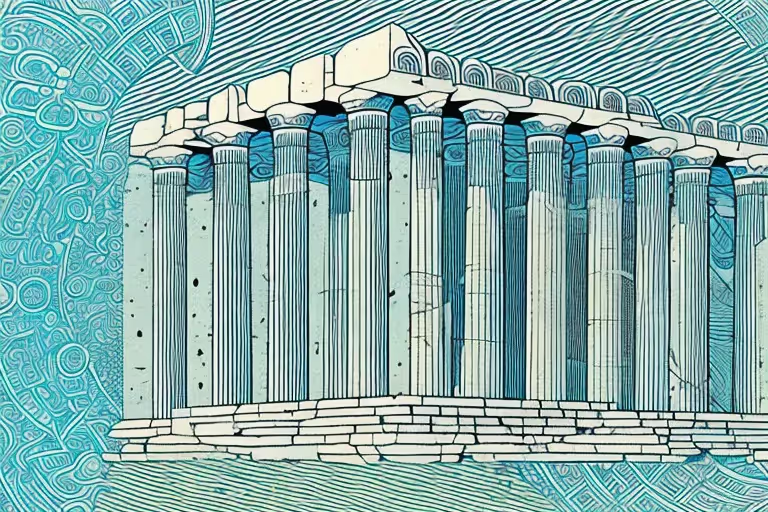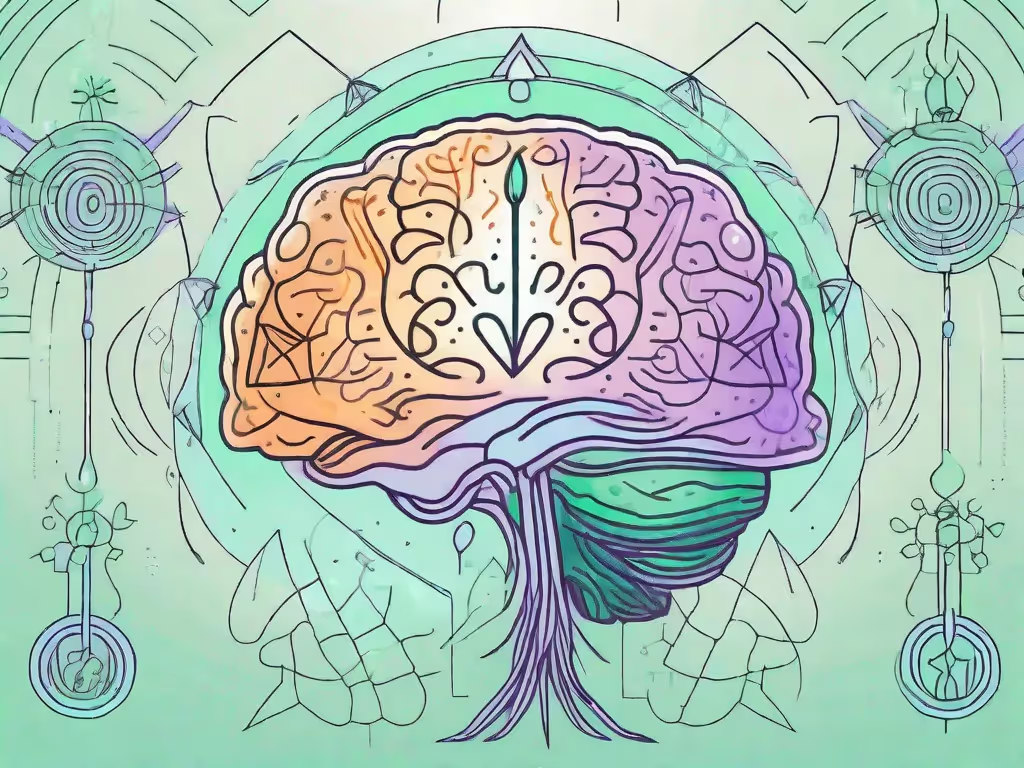Do you know what's better than an ordinary goddess? An ancient goddess! And that's where the goddess Isis comes in. She's one of the most powerful and significant goddesses from ancient Egyptian mythology, and trust us, she's got quite the story to tell. So let's delve into the origins, mythology, iconography, and worship of the one and only Isis.
The Origins of Isis
Before we get started, we gotta take things way back to ancient Egyptian mythology. We're talking waaaaaay back - like before the pyramids were even a twinkle in a pharaoh's eye. Early in Egyptian history, a pantheon of gods and goddesses emerged. Among them was Isis, goddess of fertility, motherhood, and magic.
Isis was not only a goddess but also a symbol of the ideal mother and wife. She was known for her kindness and wisdom, as well as her magical powers. Her name means "throne" or "seat," which is a reference to her role as the queen of the gods.
Early Egyptian Mythology
Isis was first worshipped in the Old Kingdom period (2686-2181 BCE) and was considered to be the daughter of the earth god, Geb, and the sky goddess, Nut. She was also the sister-wife of Osiris and the mother of Horus. Osiris was the god of the afterlife, and his story is closely tied to that of Isis.
According to legend, Osiris was murdered by his jealous brother, Set. Set dismembered Osiris's body and scattered the pieces throughout Egypt. Isis, with the help of her sister Nephthys, gathered the pieces and reassembled Osiris's body. She then used her magical powers to bring him back to life, and the two conceived their son Horus.
The Cult of Isis in Ancient Egypt
The worship of Isis was widespread in ancient Egypt, especially during the Ptolemaic era (305-30 BCE). As a mother goddess, she represented the feminine ideal and was often portrayed nursing an infant Horus. Her role as a goddess of magic made her popular among commoners and the elite alike.
Isis was also associated with the Nile River, which was essential to the fertility of the land. She was often depicted wearing a headdress that resembled a throne, which symbolized her role as the queen of the gods. Her worship was particularly popular among women, who saw her as a symbol of femininity and motherhood.
The Spread of Isis Worship Beyond Egypt
Isis worship wasn't just confined to Egypt; it spread throughout the Mediterranean world as well. The Greeks and Romans identified Isis with their own goddesses, and her worship became a widespread mystery cult throughout the Roman Empire.
The cult of Isis was particularly popular among sailors, who saw her as a protector of the sea. Her worship also spread to the city of Rome, where a temple was built in her honor. The temple of Isis became a center of worship for the cult, and it remained in use until the Christianization of Rome.
Today, the worship of Isis has largely died out, but her legacy lives on. She remains a symbol of motherhood, femininity, and magic, and her story continues to inspire artists, writers, and scholars around the world.
The Mythology Surrounding Isis
Now, let's get into the juicy stuff: the myths surrounding the goddess Isis.
The Family of Isis
Isis was born to Nut and Geb, two of the most important gods in the Egyptian pantheon. Nut was the goddess of the sky, while Geb was the god of the earth. Together, they gave birth to four children: Osiris, Isis, Seth, and Nephthys.
Isis was known for her beauty and her grace, and she was beloved by all who knew her. She was a kind and compassionate goddess, and she was always willing to help those in need.
The Legend of Osiris and Isis
This is where things get really interesting. Osiris was the husband of Isis and was the god of the underworld. He was betrayed and killed by his brother, Seth. Isis was devastated by this and went on a quest to find the pieces of Osiris's body.
She traveled far and wide, searching for each piece of her beloved husband. She eventually found all of the pieces and reassembled him. Using her magical powers, she was able to bring him back to life.
Their story is often referred to as the Osiris myth, and it represents the cycle of life, death, and rebirth that was central to Egyptian religion. It's also a great example of the love and devotion between Isis and Osiris.
Isis and the Magical Arts
Isis was also a goddess of magic, and her powers were said to be vast. She was often invoked for protection and healing, and she was considered a patron of women and children.
Her magic was so powerful that she was even able to bring Osiris back to life. She was also known for her ability to control the elements and to communicate with animals.
Isis was a revered goddess in ancient Egypt, and her influence can still be felt today. Her legacy lives on through the many stories and myths that have been passed down through the ages.
The Iconography of Isis
Isis, the ancient Egyptian goddess of motherhood, fertility, and magic, was one of the most widely worshipped deities in the ancient world. Her iconic imagery and symbolism have fascinated scholars and artists for centuries.
Now let's get into the nitty-gritty of how Isis was depicted in ancient art.
Depictions of Isis in Ancient Art
Isis was often portrayed as a tall, slender woman wearing a throne-shaped headdress or a vulture headdress. The throne-shaped headdress symbolized her role as the queen of the gods, while the vulture headdress represented her protective nature.
In some depictions, Isis was shown with wings, which symbolized her ability to fly between the earthly and divine realms. She was also sometimes depicted with a solar disk and cow horns, which represented her connection to the goddess Hathor.
Isis was often depicted holding a symbol of rebirth called the ankh, as well as the lotus and papyrus symbols of Upper and Lower Egypt. The ankh, which is often associated with Isis, represents eternal life and was used in Egyptian funerary rites. The lotus and papyrus symbols represented the unification of Upper and Lower Egypt, as well as the Nile River, which was central to the livelihood of ancient Egyptians.
Symbols Associated with Isis
Isis was associated with many other symbols in addition to the ankh, lotus, and papyrus. The scarab beetle, for example, was a symbol of resurrection and was often depicted on amulets worn by the living and the dead.
The serpent was another important symbol associated with Isis. In some depictions, she was shown with a serpent coiled around her arm or body, which represented her power over the natural world and her ability to heal and protect.
The Isis Knot and Other Sacred Objects
The Isis knot, also known as the blood knot, was a symbol of protection and magical power. The knot was often used in amulets and talismans and was believed to protect the wearer from harm.
Other sacred objects associated with the goddess include mirrors, sistrums (musical instruments), and knives. Mirrors were believed to have magical properties and were used in rituals to communicate with the gods. Sistrums were used in religious ceremonies to create a rhythmic sound that was believed to please the gods. Knives were used in rituals to symbolize the power of the goddess and were often depicted in her iconography.
The Worship and Cult of Isis
Finally, let's talk about how Isis was worshipped in ancient Egypt.
Temples Dedicated to Isis
Temples dedicated to Isis were widespread in ancient Egypt, and they were often centers of healing and magical practice. The most famous temple was at Philae, which was the last Egyptian temple to be closed by decree of the Christian emperor Justinian I in the 6th century CE.
Priesthood and Priestesses of Isis
The priesthood of Isis was made up of both men and women, and the high priestess of Isis was a very powerful figure in ancient Egypt. She was responsible for the care and well-being of the temple, as well as for conducting worship rites.
Rituals and Festivals in Honor of Isis
Isis was honored with many festivals throughout the year, including the Feast of Lamps, which was held on the 16th day of the month of Khoiak (roughly equivalent to November). The festival involved lighting lamps in honor of the goddess and was a very important event in the cult of Isis.
So there you have it, folks - the story of the ancient goddess Isis. From her origins in Egyptian mythology to her widespread worship throughout the Mediterranean world, Isis was truly one of the most significant and powerful goddesses of the ancient world.
Aura is Your All In One App for Meditation, Mindfulness Wellbeing
Find peace every day with one app for your whole well-being. There is no one-size-fits-all solution to mental well-being. Aura is the first all-in-one wellness app that learns how to best help you. Discover an endless library of expert-created tracks for your well-being, all taught by the world’s best coaches, therapists, and storytellers. With Aura's personalized recommendations, you can find peace every morning, day and night.



.webp)






.avif)

%20(1).avif)


.avif)
.avif)
.webp)


.avif)


















































































































.avif)

















.svg)









